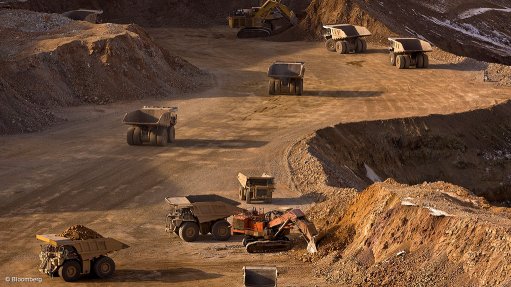
Photo by: Bloomberg
PERTH (miningweekly.com) – Softer commodity prices are expected to have a significant impact on Australia’s resource and energy commodity export earnings in 2015.
The Department of Industry, which now incorporates the Bureau of Resources and Energy Economics (BREE), expected export earnings to fall by about 10% year-on-year to A$176-billion in 2015.
BREE previously estimated that export earnings would decrease by 1.4% during 2015, to reach around A$192-billion, compared with the A$195-billion reported in 2013/14.
“While export volumes are forecast to grow for most key commodity exports, weaker commodity prices will weigh on export earnings” chief economist Mark Cully said in December.
A forecast decline in iron-ore export values, underpinned by lower iron-ore prices, was the key driver in the decline in total earnings.
“The surge in iron-ore supply has coincided with a cyclical downturn in the key Chinese housing market, contributing to a 50% drop in iron-ore prices over the course of 2014,” Cully said.
In 2014, Australia’s exports of iron-ore are estimated to have increased by 24% to 718-million tonnes. This growth was driven by an expansion to production and infrastructure capacity in the Pilbara.
In 2015, Australia’s iron-ore exports are forecast to grow by a further 6.6% to 766-million tonnes, over 50% higher than in 2012. Further growth in production by the major Pilbara producers was expected to support this forecast increase, as well as the start of shipments from Hancock Prospecting’s Roy Hill mine, which at capacity was expected to produce 55-million tonnes a year of high grade iron-ore.
Cully, meanwhile, said that a reversal of the bearish market sentiment in commodity markets was unlikely until consumption growth picked up or supply conditions tightened owing to higher cost suppliers closing down in response to the prevailing low prices.
Liquefied natural gas (LNG) export earnings would begin to increase in 2014/15 when first shipments from the east coast started as Australia sets on a path to becoming the world’s largest LNG producer. While earnings were forecast to increase, low oil prices would remain a challenge to the sector in the near term.
The start-up of the Queensland Curtis LNG project and the Gladstone LNG project, combined with the strong performance of the existing plants, was forecast to increase LNG export volumes by 11% during 2014/15, to 26.2-million tonnes.
Meanwhile, Cully noted that investment in new capacity in the Australian resources sector, combined with efficiency improvements achieved over the past year, was contributing to a forecast strong increase in export volumes.
“While the environment of weaker commodity prices is creating a more challenging operating environment for Australian producers, increased export volumes will continue to support high export earnings in the near term,” Cully said.